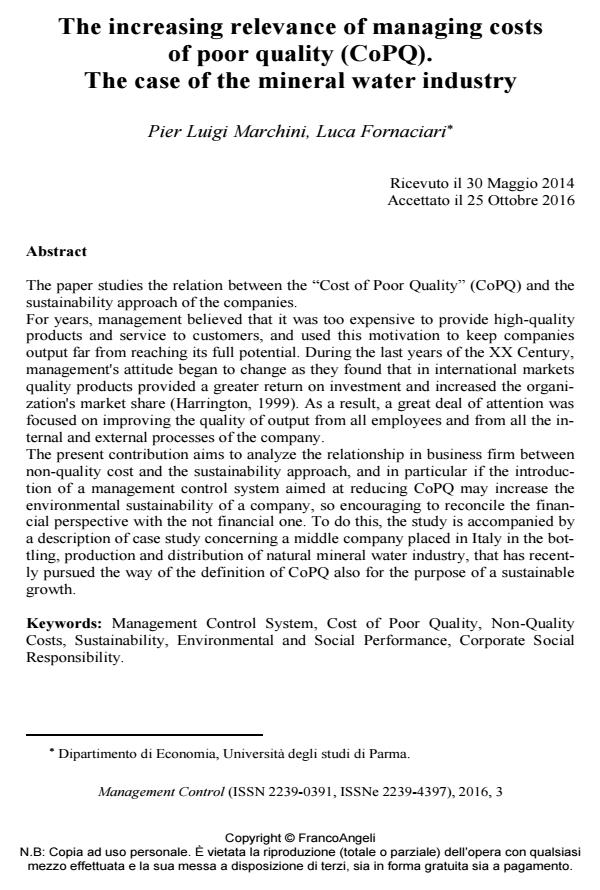The increasing relevance of managing costs of poor quality (CoPQ). The case of the mineral water industry
Titolo Rivista MANAGEMENT CONTROL
Autori/Curatori Pier Luigi Marchini, Luca Fornaciari
Anno di pubblicazione 2016 Fascicolo 2016/3
Lingua Inglese Numero pagine 32 P. 65-96 Dimensione file 556 KB
DOI 10.3280/MACO2016-003005
Il DOI è il codice a barre della proprietà intellettuale: per saperne di più
clicca qui
Qui sotto puoi vedere in anteprima la prima pagina di questo articolo.
Se questo articolo ti interessa, lo puoi acquistare (e scaricare in formato pdf) seguendo le facili indicazioni per acquistare il download credit. Acquista Download Credits per scaricare questo Articolo in formato PDF

FrancoAngeli è membro della Publishers International Linking Association, Inc (PILA)associazione indipendente e non profit per facilitare (attraverso i servizi tecnologici implementati da CrossRef.org) l’accesso degli studiosi ai contenuti digitali nelle pubblicazioni professionali e scientifiche
The paper studies the relation between the "Cost of Poor Quality" (CoPQ) and the sustainability approach of the companies. For years, management believed that it was too expensive to provide high-quality products and service to customers, and used this motivation to keep companies output far from reaching its full potential. During the last years of the XX Century, management's attitude began to change as they found that in international markets quality products provided a greater return on investment and increased the organization's market share (Harrington, 1999). As a result, a great deal of attention was focused on improving the quality of output from all employees and from all the internal and external processes of the company. The present contribution aims to analyze the relationship in business firm between non-quality cost and the sustainability approach, and in particular if the introduction of a management control system aimed at reducing CoPQ may increase the environmental sustainability of a company, so encouraging to reconcile the financial perspective with the not financial one. To do this, the study is accompanied by a description of case study concerning a middle company placed in Italy in the bottling, production and distribution of natural mineral water industry, that has recently pursued the way of the definition of CoPQ also for the purpose of a sustainable growth.
Parole chiave:Management Control System, Cost of Poor Quality, Non-Quality Costs, Sustainability, Environmental and Social Performance, Corporate Social Responsibility.
- Evaluating Quality Cost Management Systems in Morocco’s Chemical and Para-Chemical Landscape: A Comprehensive Analysis Jabri Wijdane, Azoulay Karima, Jemjami Saloua, Moustaid Khadija, in Management Systems in Production Engineering /2025 pp.171
DOI: 10.2478/mspe-2025-0017
Pier Luigi Marchini, Luca Fornaciari, The increasing relevance of managing costs of poor quality (CoPQ). The case of the mineral water industry in "MANAGEMENT CONTROL" 3/2016, pp 65-96, DOI: 10.3280/MACO2016-003005